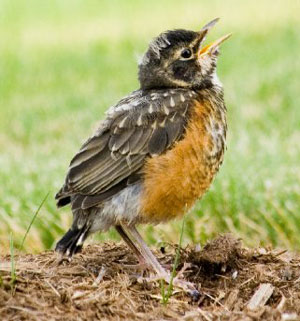 American Robin fledglingFor five years, I was the ZooCamp (www.oaklandzoo.org) director at the Oakland Zoo, a fantastic camp serving preschool to high school and offering campers a week of nature activities, animal observations, hands-on learning and fun. Along with our strategically planned activities always came those unplanned teaching moments that only nature can offer.
American Robin fledglingFor five years, I was the ZooCamp (www.oaklandzoo.org) director at the Oakland Zoo, a fantastic camp serving preschool to high school and offering campers a week of nature activities, animal observations, hands-on learning and fun. Along with our strategically planned activities always came those unplanned teaching moments that only nature can offer.
Like the time a whole group of kids stepped on a beehive. But we won’t go into that...
Let’s talk about the time that a bunch of campers found a baby bird on the ground under a tree during lunch time explorations. In they came, running and shouting about a lost and hurt and abandoned and sad and lonely and ABOUT TO DIE baby bird. Luckily, my camp staff was astoundingly educated and after observing the baby, found it to be a robin fledgling, in the middle of his flight training. The campers were directed to step way back and the staff created a barrier around the baby. The baby hopped about for a while. We observed the concerned parents squawking from the tree. Finally, down came mom and she hopped along with her baby, trying to teach him the ins and outs of flight.
The next day, baby bird was still there. And the next. And the next. The ZooCampers watched from a distance. Amazingly, the very next morning, a few staff and campers were able to witness our baby bird friend hop hop hop then fly off to a branch. Our notion to leave the baby bird and protect the area while he fledged was spot on. Hooray for nature knowledge and educational opportunities!
If you find a baby bird on the ground, ask yourself these questions:
